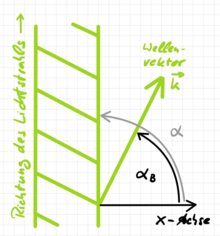Doppler effect
![]()
This article is about the Doppler effect. For the influence of kinetic energy in nuclear reactions, see Doppler broadening; for the music project of the same name, see Doppler effect (band).
The Doppler effect (rarely Doppler-Fizeau effect) is the temporal compression or stretching of a signal with changes in the distance between transmitter and receiver during the duration of the signal. The cause is the change in propagation time. This purely kinematic effect occurs with all signals that propagate at a certain speed, usually the speed of light or sound. If the signal propagates in a medium, its state of motion must be taken into account.
With periodic signals, the observed frequency increases or decreases. This applies to pitches as well as modulation frequencies, e.g. the change of tones of a Martin horn ("tatü...taataa"). For low velocities relative to the propagation velocity, this ratio also gives the relative frequency change Δ . 


Change of the wavelength with movement of the sound source

Change of wavelength due to Doppler effect
Details of the acoustic Doppler effect
When explaining the acoustic Doppler effect, it is necessary to distinguish whether the sound source, the observer, or both are moving relative to the medium (the stationary air).
Observer at rest, signal source moving
As an example, assume that the ambulance's siren emits sound waves with a frequency of 1000 Hz. This means that exactly 1/1000 seconds after the first wave crest a second wave crest follows. The waves propagate with the speed of sound 
As long as the ambulance is stationary, the wavelength λ 
For an observer on the road, these crests do arrive somewhat delayed depending on the distance. However, the time between two crests does not change. The fundamental frequency 
The situation changes when the ambulance moves towards the observer with speed 
The indices 




As a result, the frequency (i.e. the pitch) of the siren appears higher to the observer ( 

Quantitatively, the frequency change is obtained simply by substituting the relation λ 


| } |
| (1) |
|
|
Where 


When the ambulance has passed the observer, the reverse is true: the distance between the crests (wavelength) increases and the observer hears a lower tone. Mathematically, the above formula applies in the same way, you just have to insert a negative velocity for .

The described movements of the signal source directly towards or directly away from the observer are special cases. If the signal source moves arbitrarily in space with velocity 



Observer moving, signal source at rest
Even with the sound source 

respectively
| } |
| (2) |
|
|
Again, the case of a receding observer results from inserting a negative velocity.
For an arbitrary motion of the observer 


Where 



As can be seen, equations (1) and (2) are not identical (only in the limiting case 
Observer and signal source moved
By combining equations (1) and (2), one can derive an equation describing the frequency 
Transmitter and receiver move towards each other:
Transmitter and receiver move away from each other:
Where 

Frequency shift in case of scattering by a moving object
Also from the above equations, the perceived frequency can be derived when the wave from a stationary transmitter is scattered by an 





This equation is often used in acoustic or optical metrology to measure motion, e.g. laser Doppler anemometry. Especially in optics, for 
from illumination direction 

General Doppler law for sound sources
In general, the frequency difference can be written as:
Where 




The formulas were derived under the assumption that the source and observer are moving directly towards each other. In real cases, for example, the ambulance passes the observer at a certain minimum distance. Therefore, the distance between the source and the observer does not change uniformly, and that is why - especially immediately before and after passing - a continuous transition of the pitch from higher to lower can be heard.
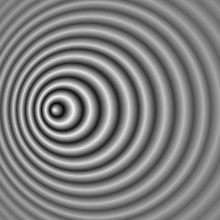
Wave fronts of a point source moving relative to the medium demonstrate the dependence of the wavelength on the propagation direction
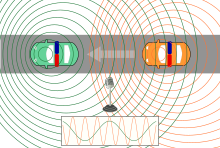
Doppler effect using the example of two moving police cars and a stationary microphone
Doppler effect without medium
Electromagnetic waves also propagate in a vacuum, i.e. without a medium. If the sender of the waves moves relative to the receiver, a shift in frequency also occurs in this case. This relativistic Doppler effect is due to the fact that the waves propagate with finite speed, namely the speed of light. It can be understood as a geometric effect of space-time.
Longitudinal Doppler effect
In a vacuum (optical Doppler effect), the observed frequency change depends only on the relative velocity of the source and observer; whether the source, the observer, or both are moving has no effect on the magnitude of the frequency change.
Due to the principle of relativity, every observer may consider himself to be at rest. However, when calculating the Doppler effect, in addition to the above considerations, he must then also take into account the time dilation of the source moving relative to the observer. Thus one obtains for the relativistic Doppler effect:

Transverse Doppler effect
If an object is moving transversely (which means "across", see the next two sections) to the observer at a certain point in time, the change in distance at this point in time can be neglected; accordingly, one would not expect a Doppler effect here. However, relativity theory states that every object is subject to time dilation due to its motion, due to which the frequency is also reduced. This effect is called the transverse Doppler effect. The formula for this is
where denotes 

However, the transverse Doppler effect can be neglected at non-relativistic velocities (i.e. velocities far below the speed of light).
Doppler effect at any angle
The Doppler effect can be specified quite generally as a function of the angle of observation. The frequency change for any observation angle α is given 
If for the angle α 
The angle of observation α 
Due to the finite transit time between the source and receiver, the angle of observation α 


Particularly illustrative is the difference between the angle of observation α 



















Where we still used the following relations: 






By the way: The transverse Doppler effect and especially this laterally drifting light beam is the key to a vivid and self-consistent description of special relativity. According to the above formula, for the case 

are supplied to the laser. Knowing now that is 




Doppler effect and astronomical redshift
Even though the observed effects of the Doppler effect and astronomical redshift are identical (reduction of the observed frequency of the electromagnetic radiation of a star or galaxy), the two should not be confused, since they have entirely different causes.
The relativistic Doppler effect is the main cause of the frequency change only if the transmitter and receiver move through space-time as described above and their distance is so small that the expansion of the space between them is relatively small. From a certain distance on, the part caused by the expansion of space-time itself predominates by far, so that the part of the Doppler effect discussed here can be completely neglected.
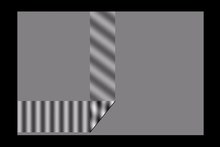
Play media file Lateral drifting light beam: The light beam here is not generated by a moving laser pointer that shines vertically upwards, but by a moving 45° mirror.
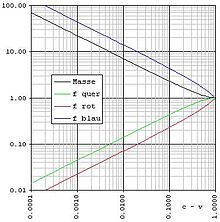
Relativistic Doppler effect and velocity
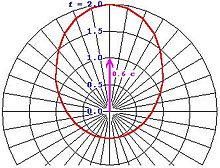
Relativistic Doppler effect and direction
Questions and Answers
Q: What is the Doppler effect?
A: The Doppler effect is a change in frequency and wavelength of a wave caused by the change in distance between the thing creating the wave and whatever is measuring, seeing or hearing the wave.
Q: What causes the Doppler effect?
A: The change in distance between the thing creating the wave and whatever is measuring, seeing or hearing the wave causes the Doppler effect.
Q: What is another word for "causer" in the Doppler effect?
A: Another word for "causer" in the Doppler effect is "sender" or "source".
Q: What is another word for "change in distance" in the Doppler effect?
A: Another word for "change in distance" in the Doppler effect is "speed" or "relative velocity".
Q: Can all types of waves be affected by the Doppler effect?
A: Yes, all the waves that can be sent out or reflected by an object can be affected by the Doppler effect.
Q: What is reflection in the context of the Doppler effect?
A: In the context of the Doppler effect, reflection refers to the change in direction of a wave.
Q: Can the sender of a wave experience the Doppler effect?
A: No, the sender of a wave does not experience the Doppler effect.
Search within the encyclopedia
















